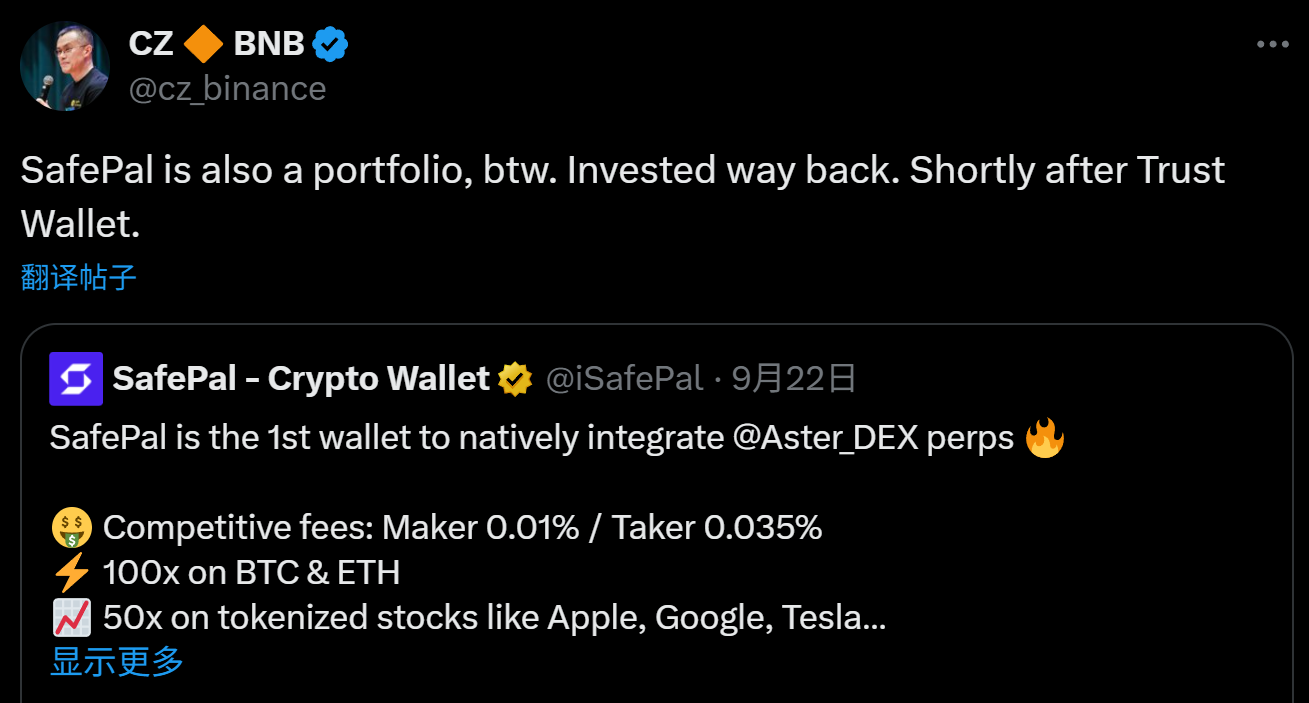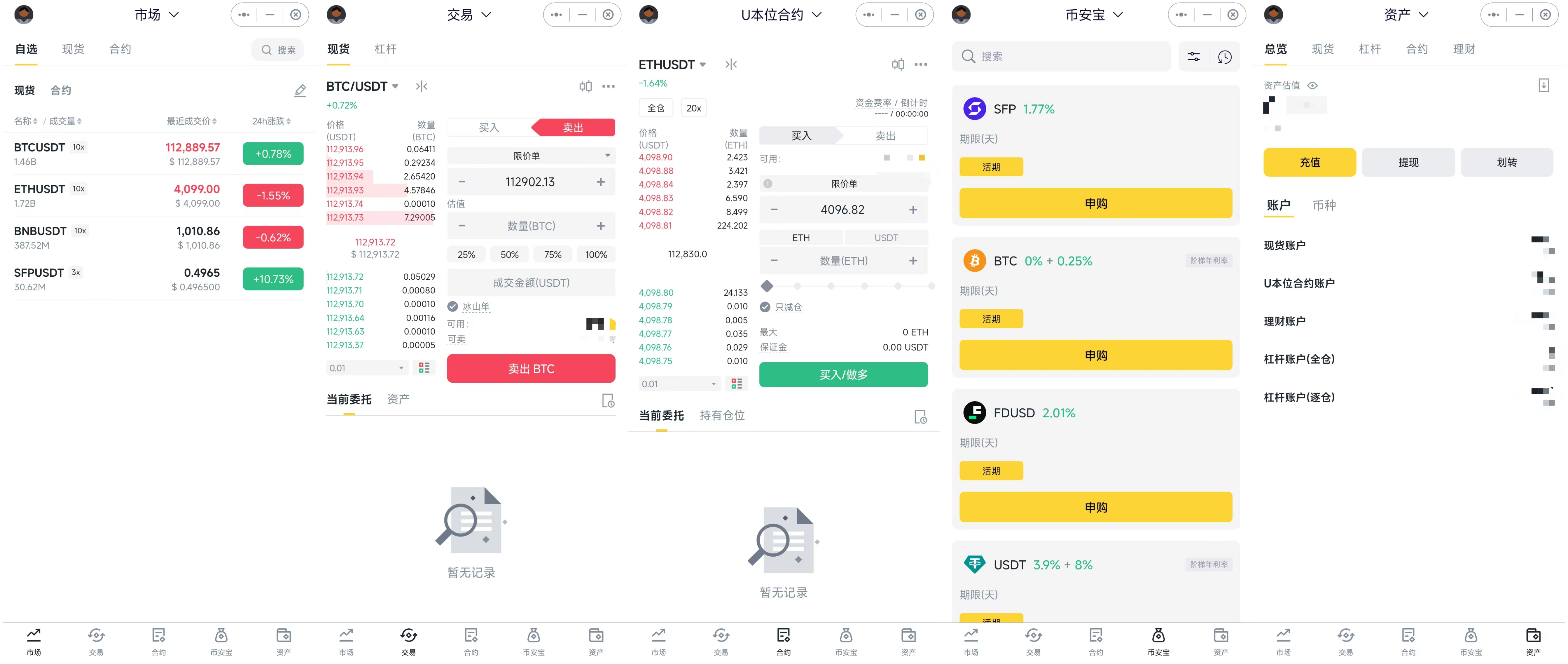Written by: Tyler
To get CZ to "shout out," one must prove that they can survive and expand within the Binance ecosystem.
How much power can a tweet have?
The answer is: it can cause a token with a market cap of over $200 million to surge by 60% in an instant.
This is the influence of CZ. On September 24, CZ retweeted SafePal's tweet about its native integration with Aster, adding, "SafePal is also in our portfolio, invested very early, right after Trust Wallet," causing the price of SFP to skyrocket.
This is not an isolated case; besides the eye-catching Aster, CZ has recently mentioned several projects invested in by YZi Labs (formerly Binance Labs), all generating significant shout-out effects.
If we look at these portfolios together, we can actually find a very clear main thread behind them.

1. The Correct Way to Open Binance's Investment Map
"SafePal is also a portfolio, btw. Invested way back."
CZ's statement has led many to summarize an intuitive screening method: to dig into the projects that YZi Labs has previously invested in, which are likely to yield the next skyrocketing targets.
This logic sounds correct, but in practice, it is akin to "finding a needle in a haystack," for a simple reason—Binance's investment map is extremely vast.
First, we need to understand Binance's investment logic. The full acquisition of Trust Wallet in July 2018 marked the starting point for the expansion of Binance's investment map, signifying its strategic evolution from a single CEX to an ecological matrix. Since then, Binance has gradually formed three major "investment levers" that cover the entire project lifecycle:
- Incubator Model (MVB, YZi Labs Incubation Program): A broad net approach to cover numerous startup teams and early potential projects, ultimately filtering and investing in some projects with relatively small amounts, mainly focusing on incubation from 0 to 1;
- YZi Labs (VC Direct Investment): Targeting more mature growth-stage projects, with higher precision and larger investment amounts, aimed at providing in-depth resource integration;
- Exchange Listed Tokens (Alpha Listings or New Token Launches): Focusing on mature projects, providing top-tier liquidity and market exposure;
Through this combination of three paths, Binance has almost encompassed projects at different stages and in different tracks, achieving a staggered layout that covers the entire lifecycle of different projects (early incubation, investment support, and listing trading), where direct investment by YZi Labs is the core of early to mid-stage ecological construction.
However, the problem is that, according to third-party statistics from the data platform Messari, YZi Labs (Binance Labs) has invested in (or laid out) over 300 projects since its establishment, clearly indicating that simply using "having been invested in" as a screening criterion is essentially like casting a net with closed eyes, which is meaningless.

So, what is the real screening logic?
From the recent cases of Aster, Sign, and SafePal mentioned by CZ, we can identify some commonalities that meet several core characteristics:
- First, there is a high degree of ecological synergy with Binance: For example, Aster, as a prep DEX, completes the on-chain derivatives puzzle and alleviates the pressure on Hyperliquid, while SafePal achieves natural ecological complementarity through its integration strategy closely aligned with Binance's product line, combining "custodial CEX & non-custodial wallet";
- Second, there must be a clear and ongoing implementation rhythm: Whether it is Aster (2021), Sign (2020), or SafePal (2018), these projects are not new stars but "veterans" that have persisted from 2018 to 2021, continuously iterating and expanding over a long cycle;
This is also the key to interpreting CZ's shout-out logic.
2. Following the Clue: CZ's "Shout-Out" Logic
If we carefully review CZ's activities over the past few months, we will find that his "shout-outs" are not impulsive; they can even be said to be intentional. By organizing the timeline, we can clearly see a logical thread that progresses step by step:
- On June 14, CZ responded to community doubts about his "shout-out for Aster," naming a batch of invested projects, including Vana, OneKey, Sign, Aster, etc., laying the groundwork;
- From June to September, CZ repeatedly mentioned or interacted with Aster, continuously injecting attention into it;
- On September 23, CZ specifically retweeted Sign, emphasizing its identity as part of the YZi Labs portfolio and revealing that he had personally facilitated its connections;
- On September 24, it was SafePal's turn; CZ not only named it but also specifically emphasized the early and strategic nature of the investment—"Invested a long time ago, right after Trust Wallet."
Aster, Sign, SafePal, Vana, OneKey, without exception, are all portfolio ecological projects that can deeply synergize with Binance's main business.

This indirectly indicates that CZ's "shout-outs" are by no means random but are consciously guiding the market to refocus on those "old practical players" that are deeply bound to the Binance ecosystem.
Taking SafePal as an example, understanding its multiple identities within the Binance map can help us grasp the underlying logic behind these "shout-outs."
In Binance's wallet layout, many may be more familiar with the earlier Trust Wallet or the recently invested OneKey, but to some extent, Trust Wallet is an old team acquired midway, and OneKey is a new player post-investment, while SafePal is truly Binance's first (hardware) wallet project that was invested in and incubated from scratch:
In September 2018, shortly after Binance acquired Trust Wallet, it included SafePal as the only wallet brand in the first incubation program of Binance Labs, completing the investment by the end of the year, while SafePal officially launched its first hardware wallet, S1, in the first half of the following year.
In other words, even before the product was officially launched, SafePal was already seen by Binance as an important piece in the hardware wallet track. This is precisely why, in the absence of a self-developed hardware wallet by Binance, SafePal remains the most strategically unique and deeply bound hardware wallet option in its ecosystem.
In addition to hardware, its app wallet has almost become an extension terminal of Binance's product matrix, nearly replicating core trading and asset management functions:
- CEX Layer: The app integrates Binance's spot, leverage, contract, and wealth management entrances, serving as a backup for the core trading & asset management functions of the main site, allowing users to directly invoke the Binance app for authorized login and trading;
- Trading Layer: Swap (supports direct use of liquidity from the Binance main site), natively supports BNB Chain and Aster, transfers BNB Chain stablecoins without gas fees;
- Asset Management Layer: Wealth management (natively supports Binance Earn), NFT, and DeFi modules are all directly connected to the BNB Chain ecosystem;
- Fiat Deposit Layer: Integrates Binance's Binance Connect fiat deposit and withdrawal channel, with built-in fiat purchase and U payment support;
- Transfer Layer: Users can directly invoke the Binance app for transfers from the app's currency detail page without needing to copy and paste wallet addresses.

Note: SafePal wallet's Binance mini program
Many seasoned investors may recall that in 2021, when Binance was clearing users from certain countries/regions, the combination of SafePal + Binance DApp became a "safe haven" for many users. This deeply bound synergistic relationship is likely one of the core reasons CZ named SafePal.
Therefore, when we pull back to view this logical line, we find that CZ's shout-outs are not just casual mentions; they point to projects that can synergize with Binance's core product matrix as "ecological puzzle" projects.
3. Value Reassessment: The Screening Game for Becoming "Ecological Puzzles"
So why is the value of these "ecological puzzles" worth reassessing by the market?
First, they all fill gaps in the Binance ecosystem:
- Aster is an important move for Binance in the on-chain derivatives track, responding to the competitive landscape between CEX/DEX and balancing emerging competitors like Hyperliquid;
- Sign positions itself in the RWA narrative, laying key groundwork for Binance in the emerging on-chain RWA market;
- SafePal, through both hardware and app dual entrances, covers Binance's core trading and asset management scenarios, becoming the non-custodial wallet portfolio closest to its main business;
In their respective tracks, they are not short-term narrative products that follow trends but exist as functional plugins in the Binance ecosystem, serving as an irreplaceable part of its strategic puzzle.
Secondly, these projects demonstrate long-term survival capabilities, having experienced complete bull and bear cycles, continuously iterating and expanding even in cold market conditions. It is this BUIDL spirit that allows their narratives to be independent of short-term emotions, instead building a moat through product and ecological synergy.
For this reason, the market capitalization of these projects is often severely mismatched with their actual ecological positions, and CZ's shout-outs often serve as an external catalyst, prompting the market to reassess their true value.

One particularly compelling signal that many have overlooked is that SafePal itself was an early investor in APX Finance (the predecessor of Aster), and this time being retweeted by CZ coincides with SafePal's launch as "the first wallet natively integrated with Aster."
This is an interesting trend, indicating that CZ also recognizes the high-quality "sub-projects" within the Binance ecosystem that can synergize with each other, creating a "1+1>2" matrix effect.
Additionally, one of SafePal's most notable initiatives this year has been its deep integration with the compliant Swiss bank Fiat24, allowing users to open bank accounts directly within the wallet and apply for a Mastercard, thereby providing a convenient channel for crypto assets to enter everyday consumption (see also: "Using U for Consumption: A Step-by-Step Guide to Registering and Using the SafePal Mastercard").
From investment to use cases, this exemplifies what CZ refers to as the value of ecological puzzles.
In Conclusion
In other words, the true selection logic behind CZ's "shout-outs" for the Binance portfolio is—not only must you be able to "survive" in a bear market, but you must also actively prove that you can expand and capture new value within the vast ecological pool of Binance.
Therefore, predicting the next lucky project to be named is essentially about finding complementary elements within the Binance ecosystem that are truly worth paying attention to as wealth-generating factors.
免责声明:本文章仅代表作者个人观点,不代表本平台的立场和观点。本文章仅供信息分享,不构成对任何人的任何投资建议。用户与作者之间的任何争议,与本平台无关。如网页中刊载的文章或图片涉及侵权,请提供相关的权利证明和身份证明发送邮件到support@aicoin.com,本平台相关工作人员将会进行核查。




